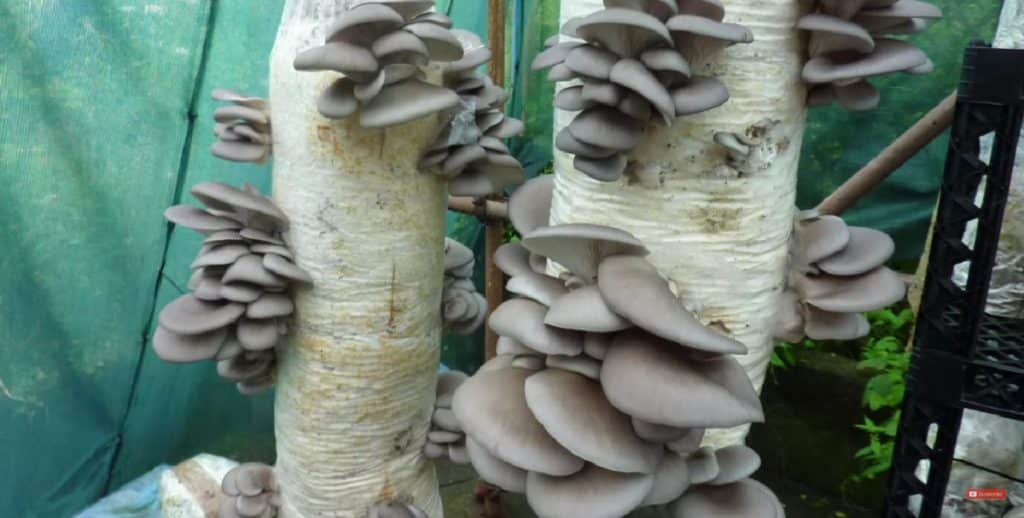Mushrooms are enjoying a surge in popularity as more people discover the health benefits of consuming these nutrient-dense functional foods.
As a result, grocery stores now carry many more gourmet species, and local farmers markets often have an impressive array of fresh and dried edible and medicinal mushrooms.
But, it can be expensive, and for many people, the best way to ensure an ongoing supply of healthy gourmet mushrooms is to grow them at home.
Fortunately, growing mushrooms is easier than most think, and if you’re lucky enough to have an existing garden greenhouse, it can help you create ideal growing conditions for mushrooms.
Wondering how to make a mushroom greenhouse?
Read on to learn the advantages of growing mushrooms in a greenhouse, how to adapt your greenhouse to grow mushrooms and how to grow mushrooms in a greenhouse step-by-step.
Why Grow Mushrooms in a Greenhouse?
Fungi need specific environmental conditions to produce mushrooms, and in the wild, they can remain dormant for several years until conditions are suitable for fruiting.
Successfully growing mushrooms at home involves replicating these ideal natural conditions as accurately as possible, and a greenhouse often makes this easier.
A greenhouse can help you maintain suitable fruiting temperatures and humidity levels, especially in a climate with extreme temperatures.
Here are some reasons why growing mushrooms in a greenhouse may be something you should consider.
- Mushrooms are commonly and successfully grown in outdoor greenhouses in several regions of China.
- Greenhouses are ideal for seasonal fruiting when temperature and humidity conditions are naturally suitable.
- Using a greenhouse to grow mushrooms is cheaper than building a year-round climate-controlled growing room.
- If you already have a greenhouse, you can make the most of any unused greenhouse space to grow mushrooms.
- You can use a small mini greenhouse to create an indoor mushroom greenhouse, often called a Martha grow tent, and grow mushrooms indoors.
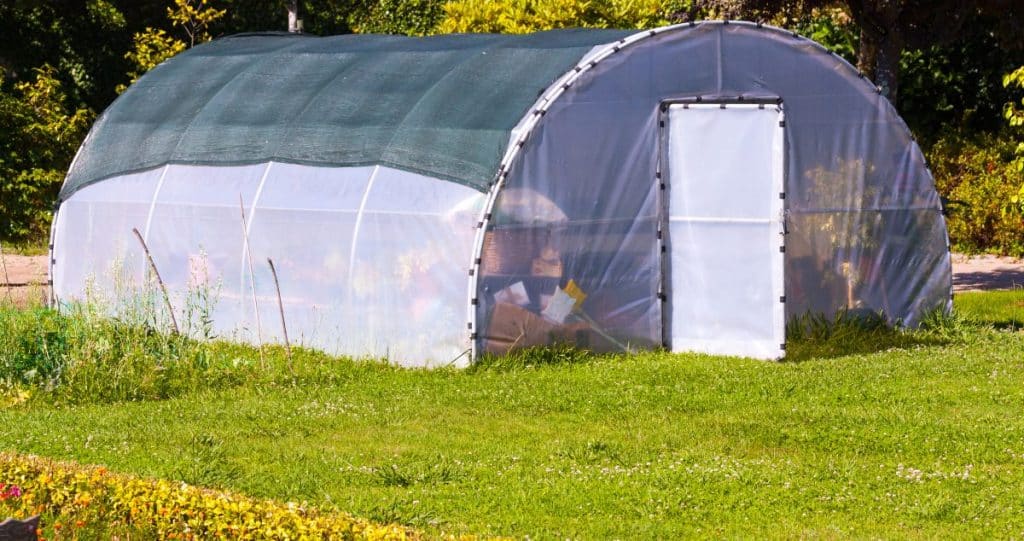
What is the Best Environment for Mushrooms to Grow?
To successfully cultivate mushrooms at home, you’ll need to provide specific environmental conditions tailored to the type of mushroom you’re growing.
During colonization, your substrate should provide the moisture and nutrients required for the mycelium to grow. As the fungus does not need light at this stage, you only need to ensure that temperatures and fresh air exchange are correct.
But during the fruiting phase, mushrooms need specific temperatures, lighting, humidity, and fresh air to grow and develop healthy, well-shaped fruiting bodies.
Our comprehensive guide on the conditions needed for mushrooms to grow has more information for you.
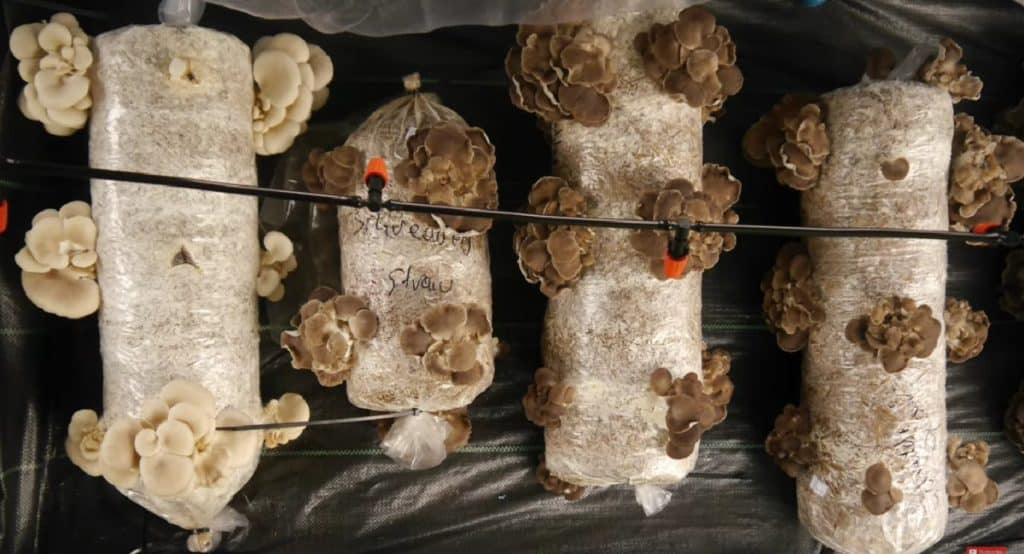
How can I Convert my Greenhouse Into a Mushroom House?
To transform a garden greenhouse into a mushroom cultivation space, you’ll more than likely need to make a few adjustments to create ideal mushroom growing conditions, including:
Reducing the Amount of Light
If your greenhouse is in full sun, you’ll need to install shade cloth or something similar to reduce the amount of light in the greenhouse.
Although mushrooms need some light to grow properly during the fruiting phase, indirect light is best, and most gourmet mushroom species don’t grow well in direct sunlight.
Regulating the Temperature
Mushrooms thrive in specific temperature ranges that vary from species to species.
Generally, mushrooms enjoy temperatures between 55 and 75°F (13 and 24°C), although some species, like oyster mushrooms, will grow in temperatures of up to 86°F (30°C).
Depending on your location, installing shade cloth may be enough to achieve ideal temperatures, especially if you’re aiming for seasonal fruiting.
But, if your climate is more extreme or you want to grow mushrooms year-round, you may need to introduce a heating or cooling system to maintain ideal temperatures in the greenhouse.
Maintaining Humidity Levels
Mushrooms typically need humidity levels of 85 to 95% to grow, and depending on your location, you may need to install a humidifier or misting system to maintain these humidity levels.
But greenhouses naturally tend to maintain high humidity, so if you live in a moderate, humid climate, you may not need any extra equipment to provide the required humidity levels.
Providing Adequate Airflow
Adequate air circulation is vital for successful mushroom cultivation, but not so much that it reduces the humidity levels.
Your greenhouse will need some form of ventilation mechanism or fan to provide the consistent fresh air exchange that mushrooms need to grow.
Depending on your climate, balancing fresh air exchange and humidity levels can be one of the most challenging aspects of growing mushrooms.
Reducing Pests
If your greenhouse has ventilation openings, we suggest installing fly screens to prevent pests from entering the growing space.
If you’re already growing plants or vegetables in your greenhouse, you will more than likely already have screens up to prevent insects from eating your crop.
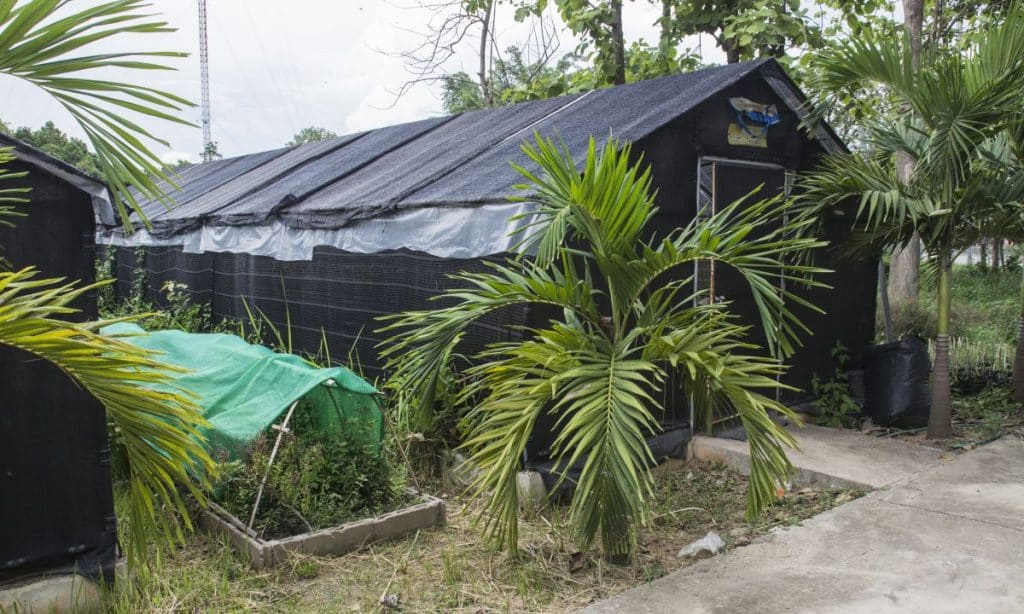
Equipment Needed to Grow Mushrooms in a Greenhouse
The equipment you need will vary significantly depending on the size of the greenhouse and ambient climate conditions in your area, but will most likely include:
- A fan to provide fresh air exchange
- A humidifier or spray nozzles to create humidity
- Fly-screen netting to prevent pests from entering the greenhouse.
- Shade netting if the climate is very hot to block direct sunlight and help reduce temperatures
- Shelving to hold your containers of substrate if growing in bags or trays
This video from What The Fungus will give you an idea of what a commercial greenhouse mushroom farm looks like.
Types of Mushrooms You Can Grow in a Greenhouse
If you adapt your greenhouse in such a way that you can provide ideal fruiting conditions, you could grow most edible mushroom species in a greenhouse.
Popular choices for growing mushrooms in bags in greenhouses are oyster and shiitake mushrooms, as they’re some of the easiest mushrooms to grow.
Growing button mushrooms in trays is also a favorite for greenhouses, and you can also grow species that people grow in garden beds in greenhouse trays. Examples of these are wine caps, shaggy manes, king oysters, pioppinos and elm mushrooms.
Additionally, any mushroom species that you can grow outdoors on logs, including lion’s mane, maitake, nameko and chicken of the woods, will happily grow in a greenhouse without needing many modifications.
Apart from delicious gourmet mushrooms, you can also grow a few medicinal mushroom species in a greenhouse.
Reishi mushrooms are one of these species. They enjoy the hot, humid conditions inside greenhouses, and people often grow them in greenhouses in bags or on logs buried under soil.
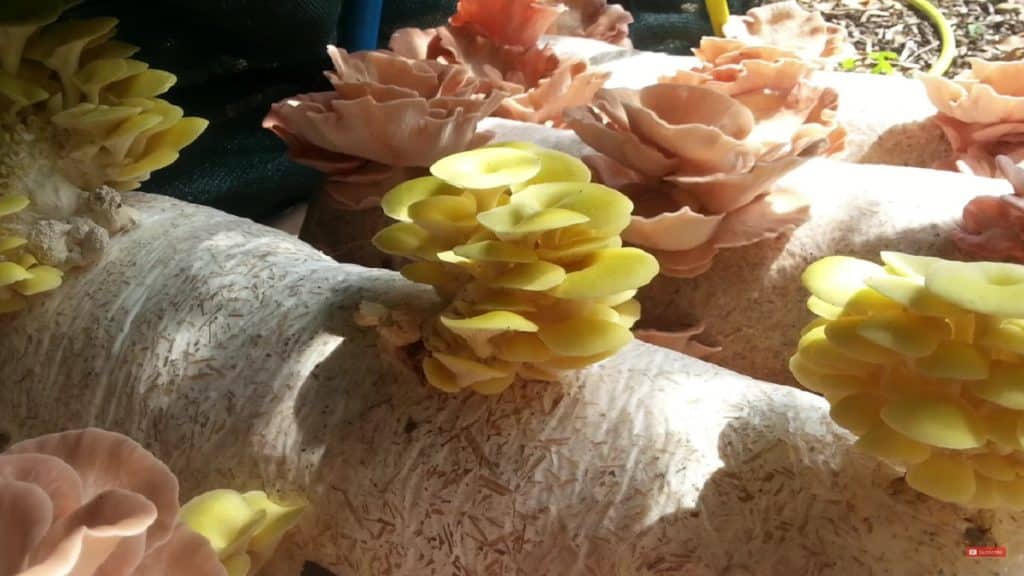
How to Grow Mushrooms in a Greenhouse Step-by-Step
In this step-by-step guide, we walk you through the steps needed to grow mushrooms in an outdoor greenhouse.
Before you begin, you’ll need to make a few decisions that will impact the supplies you’ll need, including:
- Which mushroom species do you want to grow? If you decide on an easy-to-grow mushroom species that tolerates a wide range of temperatures, your greenhouse may need fewer adaptations.
Additionally, the species you choose will dictate the type of growing medium or substrate you’ll need and the growing methods you can consider. - Which method are you going to use: bags, trays or logs? Many easy-to-grow mushroom species can be grown in bags, buckets, trays, garden beds or logs.
When deciding which method to use, consider the available space in your greenhouse and what type of organic substrate material is easy to get locally.
The easiest way for beginners to grow mushrooms for the first time is to buy a mushroom growing kit that contains a fully colonized fruiting block.
All you’ll need to do is open the growing kit, place it in a spot in the greenhouse with indirect light, monitor the temperature and mist the mushrooms with water when necessary to maintain humidity levels.
Once you have some experience, you may want to move on from growing kits and be more involved in other mushroom growing stages.
Generally, the next step in your mushroom growing journey would be preparing and inoculating a substrate and monitoring it during incubation while the mycelium colonizes the organic material you have provided.
We recommend beginners start with hardy species like oyster mushrooms or wine caps that will grow on pasteurized straw or wood chips and don’t need sterilized substrates.
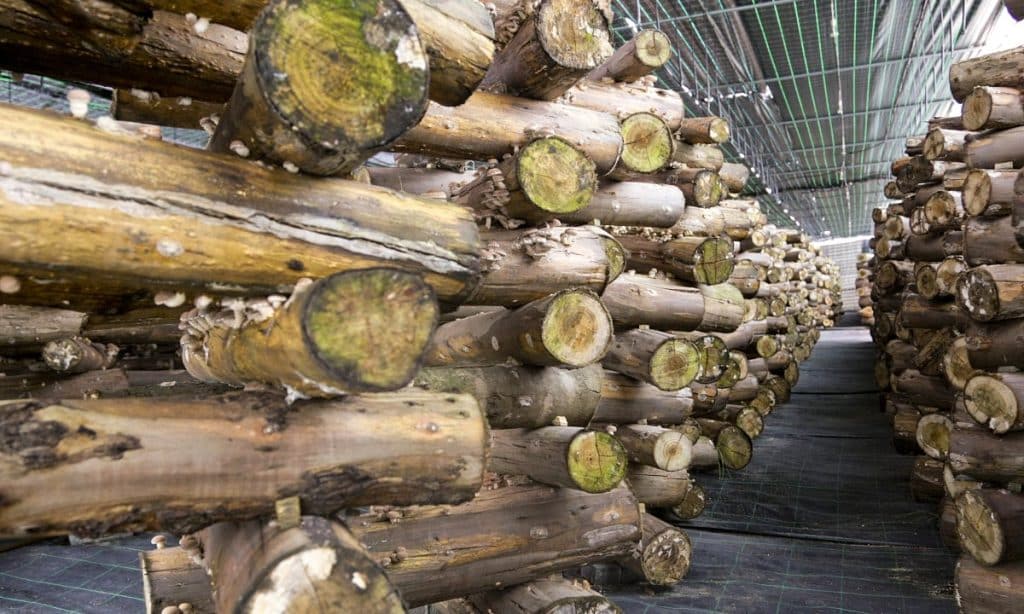
Here are some steps you can follow to grow mushrooms in an outdoor greenhouse:
Step 1: Adapt Your Greenhouse
There are two main advantages to growing mushrooms in a greenhouse instead of outdoors.
Firstly, a greenhouse can help protect the mushrooms from sudden changes in humidity or temperature and extreme weather events.
But depending on your environment, an unmodified greenhouse may not be adequate. You could need shade cloth and other equipment, like a humidifier or fan, to create suitable growing conditions.
The second thing a greenhouse does is to help keep out animals, birds, pests and diseases that can ruin outdoor mushroom crops. Depending on the design of your greenhouse, you may need to install screens to keep out smaller insects like flies.
Finally, based on the growing method and your mushroom greenhouse design, you may want to install shelving to hold your mushroom growing bags or trays.
Free-standing, vertical shelving is a popular solution that increases the amount of growing space and allows you to grow more mushrooms.
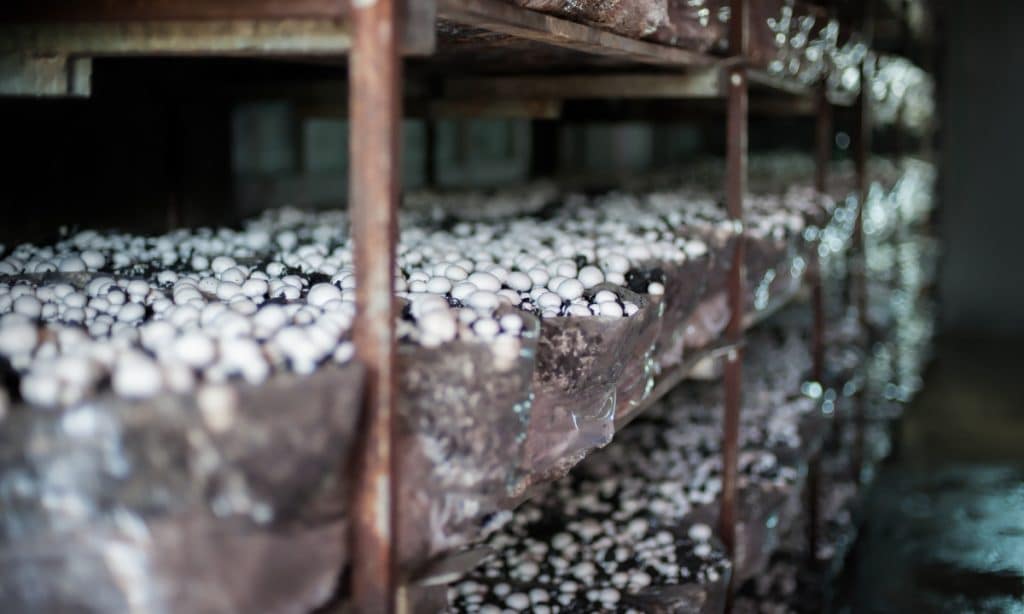
Step 2: Gather Supplies
The mushroom growing supplies needed to grow mushrooms in a greenhouse will vary depending on the species and method you have chosen, but generally, you’ll need the following items:
Mushroom Spawn
We recommend purchasing high-quality mushroom spawn from a reputable supplier nearby.
There are three kinds of mushroom spawn for growing mushrooms: grain spawn, sawdust spawn and plug spawn. Which is best to use will depend on the growing method you have chosen.
Substrate (The Growing Medium)
We recommend beginners start with mushrooms that grow on less nutritious substrates like straw and sugarcane bagasse, as these only need pasteurization.
Hardwood wood chips and compost are also popular mushroom substrates that people often use to grow mushrooms outdoors, but there can be an increased risk of contamination.
If you have enough space in your greenhouse, the patience to wait a while and access to fresh hardwood logs, growing mushrooms on logs is also a good option for beginners.
But, if you have a little experience and want to grow mushrooms that prefer supplemented hardwood sawdust substrates like Master’s Mix, you’ll have to sterilize your substrate.
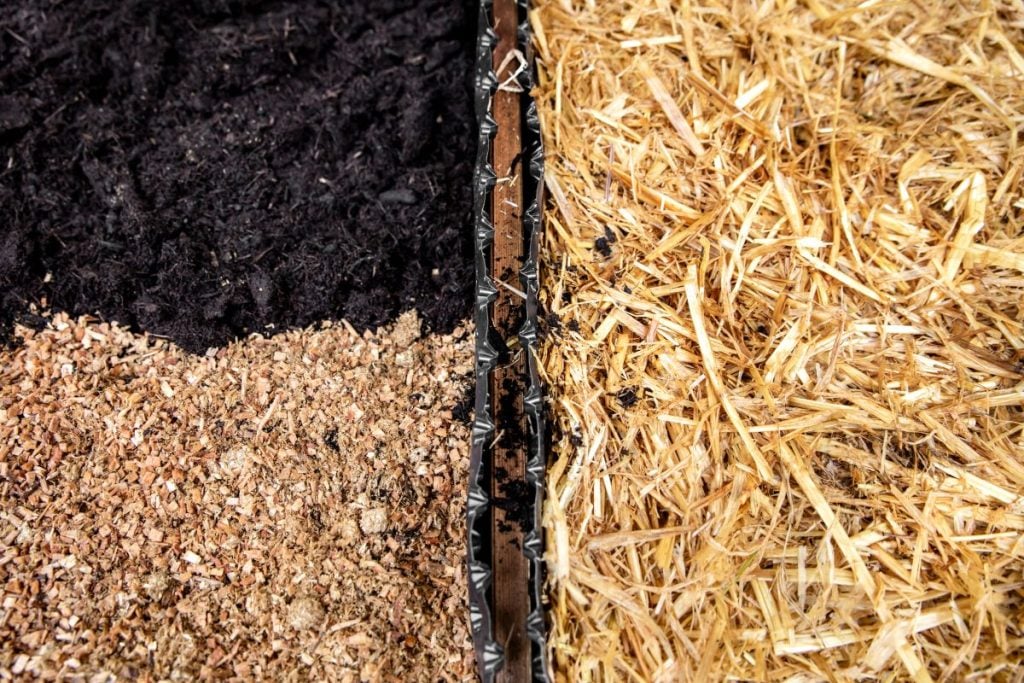
Containers
Unless you plan on growing mushrooms on logs, you’ll need to source containers to hold your substrate.
Popular container options for growing mushrooms in greenhouses are mushroom growing bags or plastic trays for top-growing species like button, king oyster, wine cap or reishi mushrooms.
A Thermometer
A thermometer will help you to keep an eye on the temperature inside your greenhouse to ensure it does not get too hot or cold for the mushroom species you are growing.
Different types of mushrooms thrive at different temperatures and may also need different temperatures for incubation, pinning and fruiting.
Always follow the instructions included with your mushroom spawn. If there are none, refer to our growing guides or do some online research to find the ideal temperatures for your mushrooms.
You can buy thermometers from general retail stores or online, but make sure the one you select can withstand the high relative humidity levels (85 to 95%) required for growing mushrooms.
A Hygrometer
A hygrometer measures the moisture content in the air and can be a helpful tool for growing mushrooms in a greenhouse.
If you’re growing hardy mushroom species and misting them a few times daily to increase humidity, you most likely won’t need a hygrometer.
But if you’re growing fussier species or using a humidifier to increase humidity levels, a hygrometer can be helpful, as humidifiers can generate excess moisture, especially in a greenhouse.
If you don’t have an automated humidity controller, a hygrometer will allow you to monitor humidity levels and adjust or turn off your humidifier when necessary.
You can also buy a combination thermometer and hygrometer especially designed for use in greenhouses.
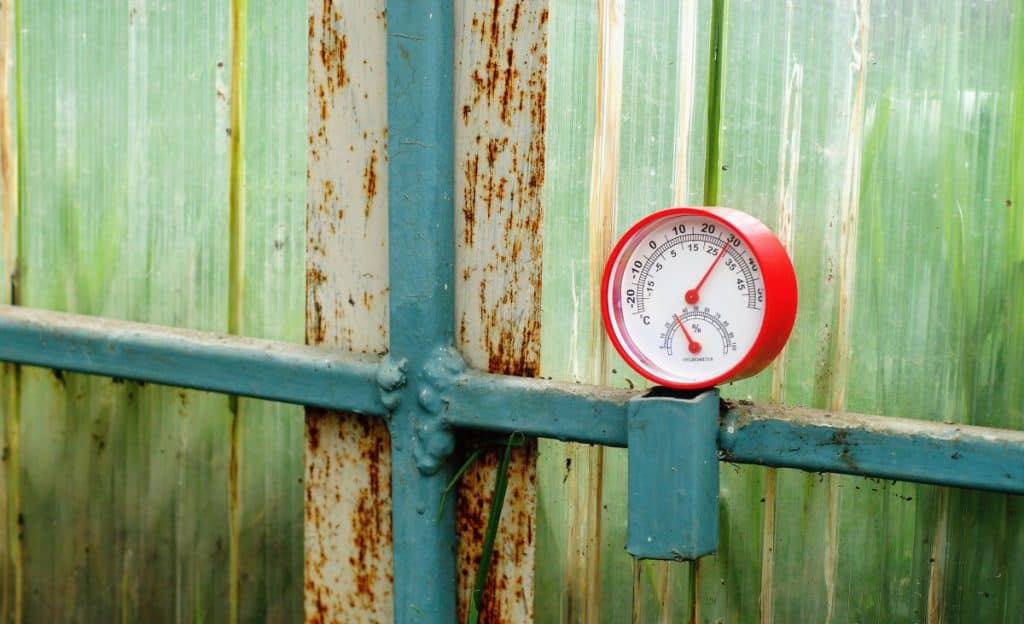
Step 3: Prepare Your Substrate
When your greenhouse is ready and you have all your supplies, you can move on to the next step, preparing your substrate for inoculation.
This may involve pasteurizing straw, sterilizing supplemented sawdust blocks, drilling holes in logs or preparing compost for button mushrooms.
Generally, when preparing bulk substrates for inoculation, two things are needed.
First, you need to hydrate the substrate to field capacity. Then, pasteurize or sterilize the substrate to reduce or kill any living organisms that may compete with your mushroom mycelium.
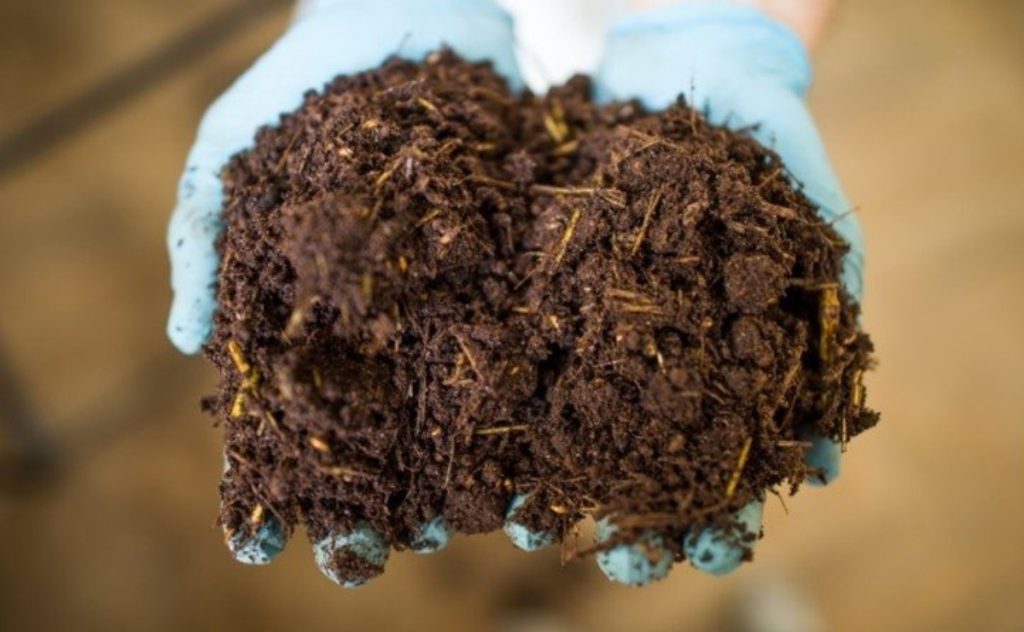
Step 4: Inoculate Your Substrate
When growing mushrooms at home, you need to mix your mushroom spores or spawn into a suitable nutrient medium (your substrate) for them to grow and produce mushrooms.
Mushroom cultivators call this process inoculation. You’ll come across many industry-specific mushroom-growing terms on your mushroom-growing journey, and ‘inoculation’ is one of them.
There are several inoculation methods you can use and which is best will vary depending on the mushroom species, growing method and substrate you have chosen.
To learn more about mushroom inoculation, please read our article, “Mushroom Inoculation: Spawn, Substrate, Logs & Beds.“

Step 5: Incubation
After you have inoculated your substrate, the next step is to incubate it.
This usually means placing your substrate in a warm, dark location for a period ranging from a few weeks to a few months. The optimal temperature range for most species during incubation is 68 to 75°F (20 to 24°C).
Incubation times vary based on factors like temperature, spawn rate, substrate composition, and mushroom species.
During incubation, the mushroom mycelium grows outward from the spawn you introduced and spreads throughout the substrate, feeding on the organic material in the substrate.
Mushroom growers call this process colonization. (Another unique mushroom growing term.)
When colonization is complete, your substrate will often end up completely covered in white mycelium, and if small bumps or mushroom pins are beginning to emerge, it’s time for fruiting.
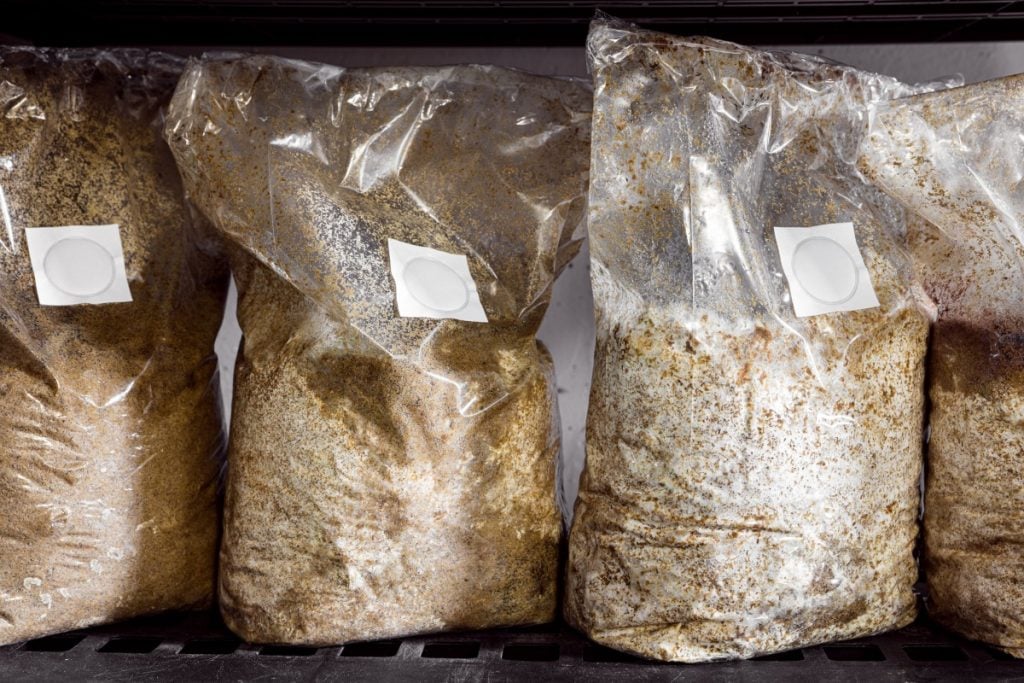
Step 6: Fruiting
Fruiting is the most exciting phase of mushroom cultivation as you finally watch your mushrooms grow.
To initiate fruiting, you’ll need to expose the mycelium in your fully colonized substrate to fruiting conditions, meaning you’ll need to replicate the mushroom’s natural fruiting environment.
The first stage of mushroom growth is pinning, during which humidity levels are crucial. If you allow the tiny mushroom pins to get too dry, they will shrivel up, go black and die.
Generally, key factors for fruiting success include adequate ventilation, humidity levels of 80% or higher, indirect sunlight, and temperatures ranging from 50 to 75°F (10 to 24°C).
Depending on the mushroom species, you may be able to harvest your first flush of mushrooms in under two weeks, but not all mushrooms grow that fast.
Our article, “How Long Does It Take To Grow Mushrooms? All Questions Answered.” has more information on how long it takes to grow different species and factors that influence growth rates.
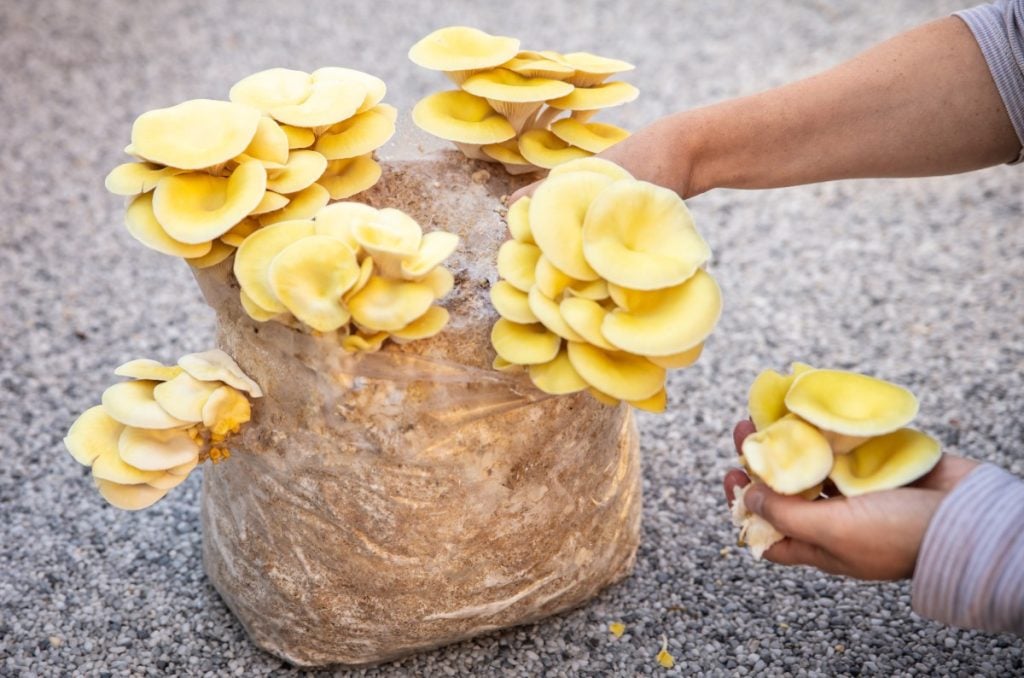
Common Issues and How to Troubleshoot Them
As with most things worth doing, growing mushrooms is a learning curve, and there are several things you’ll more than likely learn through trial and error.
Knowing how to avoid common problems can help you succeed sooner, and we have an article to help with this called “Top 12 Common Mistakes Mushroom Growers Make.”
Depending on how many modifications you make, growing mushrooms in a greenhouse could be like growing them outdoors, only with more protection from extreme weather and pests.
Or, growing mushrooms in a very secure, automated greenhouse can be like growing them in an indoor mushroom grow tent, but with more potential climate challenges.
Here are some common issues you may come across when growing mushrooms in an outdoor greenhouse as opposed to indoors:
Excessively High Temperatures
One of the main issues people have when growing mushrooms in an outdoor greenhouse is it can get too hot in summer.
Installing shade netting and ensuring adequate ventilation can help with this, but if it’s still too hot, you’ll need to install a cooling system or only grow mushrooms during cooler months.
More Pest Exposure
It can be hard to prevent pests like mushroom flies or slugs from getting to your mushrooms in an outdoor greenhouse.
Your greenhouse should be fully enclosed, and we recommend covering any ventilation openings in a fine fly-screen mesh to help prevent insects from damaging your mushroom crop.
Frequent Temperature Variations
Outdoor temperatures can change dramatically, from day to night, making mushroom growth rates slower and less predictable.
Heating pads or mats are a popular and relatively inexpensive way to ensure your mushrooms don’t get too cold at night.
They come in various sizes, are easy to place under your growing containers, and you can adjust them to the desired temperature.
Extreme Weather Damage
Extreme weather events, like strong winds or hail storms, can cause serious damage to an outdoor greenhouse.
To help prevent this, ensure your greenhouse is structurally solid and, if possible, place it in a location naturally sheltered from extreme weather events by trees or buildings.
Final Thoughts
Using an existing greenhouse to grow mushrooms can be a cost-effective way to protect your mushrooms from extreme weather, insects and diseases, increasing your harvest.
And, if you live in a location where temperature and humidity conditions are naturally suitable, it won’t take many adjustments to transform a garden greenhouse into a mushroom cultivation space.
Depending on the space in your greenhouse, you have several options, including growing mushrooms in bags on shelves, stacked buckets, flat trays (alone or with plants) or on logs.
To learn more about growing mushrooms indoors and outdoors, visit our Mushroom Growing Hub or sign up for one of our mushroom cultivation courses.
